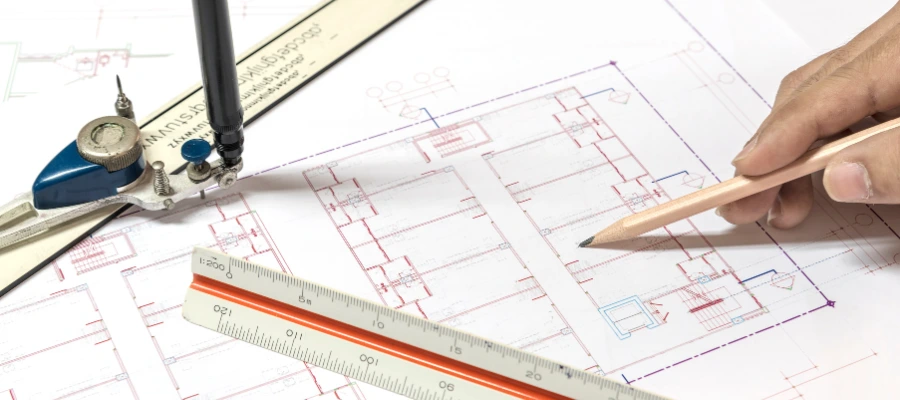The method of finding how a structure will react to various loads and forces is known as structural analysis, and it is a basic component of civil engineering. It helps verify the ability of buildings, bridges and other structures to support a number of loads and forces. Structural analysis measures the internal forces, stresses, strains and displacements and looks at how it respond to different conditions. This will ensure that engineers can design safe and effective infrastructure for the loads for which it is created.
The weight of the structure itself (called dead load), the weight of movable or temporary loads on the structure like people, furniture or cars (called live load) and the force of the natural factors like the wind (called wind load) and earthquakes (called earthquake load) can all be understood by structural analysis. The meaning of structural analysis, its uses, methods and the function of structural engineers in modern structures are all covered in this blog.
What is Structural Analysis?
Structural analysis is the method of finding how the different types of loads and internal forces affect physical structures and each of their elements. It checks the strength, stability and durability of civil engineering structures and makes sure the structure is strong enough to face normal use and harsh environments without failing. A key element of structural engineering is the need for structural analysis in order to create long-lasting and safe designs. The behaviour of a structure under different conditions is calculated by engineers using many kinds of mathematical models, computer tools and experimental methods.
The Role of Structural Engineer
In the design and building of any structure, a structural engineer is important and their task is to make sure that the infrastructure is strong, safe and useful. Their roles are discussed below.
- Structural designing is a method of developing specifications and blueprints that match the performance and safety needs.
- Load analysis involves finding the forces acting on the structure, including both static and dynamic loads and measuring the effects of various loads to avoid structural failures.
- Ensuring safety means the structure must withstand adverse weather conditions such as earthquakes, floods, or heavy snowfall. It should also be capable of resisting both environmental forces and human-induced loads.
- Selecting suitable materials to balance durability, strength and affordability helps engineers to create sustainable and cost-effective structures.
- Working together with contractors, architects and other engineers to make the project a reality and ensure that the structures follow international and national safety regulations is known as collaboration.
Without structural analysis, a structural engineer’s work will lack the technical precision needed for safety and reliability.
Types of Structures in Civil Engineering
Civil engineering covers the designing and construction of a wide range of structures. Each type of structure has different features and needs specialised analysis techniques. Some types of structures in civil engineering are:
- Buildings are the most common constructions from small homes to huge skyscrapers. There are commercial, industrial and residential buildings.
- Bridges are available as suspension, beam, arch or cable-stayed.
- The purpose of dams like embankment dams, arch dams and gravity dams is to hold back water.
- Tunnels are used for water management, utilities and transportation.
- Towers can be observation, transmission and communication towers.
- Retaining walls are made to keep water or dirt out of places where the elevation changes.
- Shell structures are thin, curved structural elements that are commonly used to carry loads during membrane and bending movements because of their strength-to-weight ratio and capacity to span large areas without the need for internal support.
Structural analysis helps engineers in solving different problems that each structure faces.
Applications of Structural Analysis
At every stage of a project from design to building and repair structural analysis is used. Some applications of structural analysis are:
1. Design optimisation – Ensuring the structure is safe and cost-effective by doing structural analysis and simulation.
2. Failure investigation – Analysing failed structures to find the cause and prevent future issues.
3. Retrofitting – Maintaining current safety standards by protecting existing structures.
4. Dynamic analysis – Studying the way in which structures react to dynamic loads like explosions or earthquakes.
5. Fatigue analysis – Assessing the impact of repeated loading on a structure’s lifespan.
Methods of Structural Analysis
Various methods have been used over the years for doing structural analysis from advanced computational methods to manual calculations. These days engineers have many different kinds of tools at their use depending on the complexity of the structure and the forces acting on it. Here are some most used methods:
1. Manual calculations
Manual computations are still important for checking computational outcomes and are often used in academic settings and early stages of design. This method is time-consuming and can cause human error.
2. Matrix Methods
Matrix methods, like stiffness and flexibility methods, are used to analyse complex structures. This method uses matrices to simplify the stiffness calculation of the structure and solve them to find the internal forces and displacement.
3. Finite Element Structural Analysis
One of the best methods for studying complex structures in modern structural analysis is finite element analysis (FEA). The structure can be divided into smaller finite elements and the equations for each element like stresses, deformation and overall performance are solved numerically. Advanced structural analysis uses FEA because of its accuracy and capacity to manage complex issues.
4. Softwares
Modern structural analysis mostly makes use of modelling and simulation software tools like finite element analysis (FEA), and packages like STAAD.Pro and SAP2000.
5. Dynamic Analysis Methods
The response of structures to dynamic loads is measured using methods like time-history analysis and model analysis. These methods are important for creating structures that survive earthquakes.
6. Nonlinear analysis
Structures showing nonlinear behaviour like plastic deformation or large displacements can be studied using nonlinear analysis. While this method is more difficult it gives a clearer picture of the actual situation.
Advanced Structural Analysis

As technology grows, the methods and tools used in structural analysis also change. The following are a few recent developments:
1. Computational fluid dynamics (CFD) – To model and analyse heat transfer and related processes, computational fluid dynamics or CFD is used. Structural engineers use it when fluid-structure interaction is a problem like wind loading on tall structures or water flow around bridge piers.
2. Machine learning – It is a new technology in structural engineering that is mostly used for predictive maintenance, design parameter optimization and pattern identification in structural health monitoring. Its application to core structural analysis is still in the early stages.
3. BIM (Building information modelling) – Combining 3D modelling and structural analysis can increase efficiency and teamwork.
4. Real-time monitoring – Real-time structural health monitoring uses sensors that constantly monitor performance metrics like displacement, vibration and stresses. This helps in the early identification of anomalies that could point to structural collapse or failure.
Structural engineering is changing as a result of these developments that help engineers to work on more difficult problems.
Structural Engineering Basics
Designing and analysing structures is the main focus of the specialised area of structural engineering. Buildings, bridges and other infrastructure are made safe, useful and stress-resistant by engineers. Those who are new to structural engineering need to have a basic knowledge of the field. Here are some important ideas:
- Dead loads, live loads and environmental loads are the forces that are applied in a structure. The ability of a structure to carry weight is known as its load-bearing capacity.
- The internal resistance to an applied force is known as stress and the deformation caused by stress is known as strain and it measures how a material changes under pressure.
- Material properties are the features of building materials like ductility, strength and elasticity.
- The ability of a structure to hold its shape and prevent collapse is known as structural stability.
- Safety factors are extra safety margins added to designs that take unexpected events into consideration.
The foundation of civil engineering is structural analysis which gives the efficiency, durability and safety of structures. The methods have grown to satisfy the needs of modern engineering, going from manual computations to advanced finite element structural analysis tools. Structural engineering will play an even more important role in forming the built environment as technology advances. Engineers can create structures that not only satisfy functional needs but also last throughout time by understanding the basics and applications of structural analysis. The core of our world is structural analysis, whether it be a bridge or a tall skyscraper.

